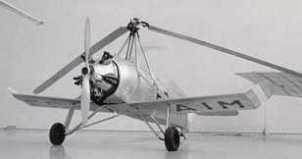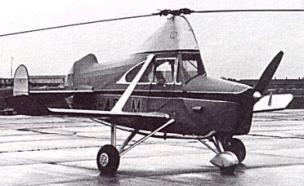
CIERVA C.19 MARK IV
""
DE
LA CIERVA
CIERVA C.19 / C.28 |

CIERVA C.19 MARK IV

CIERVA C.24

CIERVA C.26
|
|
|
El modelo C.19 fue el más prolífico de la serie Cierva, del que se construyeron una serie de variantes, casi todas por AVRO. Los tres primeros denominados AVRO TIPO 620 se proyectaron como el C.17 MKII. En esta serie se dispuso un sistema de arranque automático para hacer girar el rotor, tarea que hasta ese momento se venía realizando con una cuerda. Los tres C.19 MK I tenían un motor Armstrong Siddeley Genet II de 80 hp. A estos le siguieron tres C.19 MK II y un C.19 MK IIA con cabeza de rotor mejorada, seis C.10 MK III , 15 C.19 MK IVP y un C.10 MK V experimental, todos ello con motor Genet Major 1 de 105 hp. Un lote de C.19 MK IV construidos bajo licencia en Alemania por FOCKE-WULF con motor radial Siemens Sh.14B de 150 hp, recibieron la designación de C.20. La designación C.21 fue para un proyecto en Francia para construir el C.19 MK IV por Liore-et-Olivier. Los C.22 y C.23 no pasaron de la etapa de proyecto. El Cierva C.24 fue un diseño con cabina cerrada biplaza construido por Havilland Aircraft Co. con un motor Havilland Gipsy III de 120 hp y cabeza de rotor suministrada por Cierva con rotor tripala. Provisto luego con un rotor bipala fue designado C.26. El C.25 fue el autogiro más pequeño construido por Comper Aircraft volando por primera vez en 1933 con un motor Pobjoy Niagara R de 85 hp, pero no entro en producción. En 1932, la compañía francesa Lioré-et-Olivier adquirió una licencia de fabricación y basados en el C.19 MK IV , construyó el C.27, bajo designación propia de CL-10, tenia cabina cerrada biplaza, sin alas y un motor Pobjoy de 75hp. El C.28 fue construido por G & J Weir en Glasgow voló en 1933 dándole la designación W-1, con un motor Douglas-Dryad de 40 hp, luego esta compañía seria absorbida en 1943 por Cierva Company. Westland en 1934 intentó desarrollar un autogiro con cabina para 5 plazas, con un motor radial Armstrong Siddeley Panther II de 600 hp, pero no llegó a volar debido a problemas de resonancia. |
|
|
|
The model C.19 was the most successful of the Cierva series, which included a series of variants. Almost all were built for AVRO. The first, known as AVRO Type 620, was originally known as the C.17 Mk II. A system of automatic starting was included, where previously a rope was used to start the rotor turning. The three C.19 MK I prototypes had an Armstrong Siddeley Genet II engine of 80 hp. Subsequent developments included three C.19 MK II and a C.19 MK IIA, with improved rotor head, six C.10 MK III, 15 C.19 MK IVP and a C.10 MK IVexperimental. All the latter machines were powered by Genet Major 1 engines of 105 hp. A number of C.19s were built, in MK IV variant, under license in Germany by FOCKE-WULF with Siemens Sh.14B radial engines of 150 hp. They were given the designation C.20. The designation C.21 was for a project in France to build the C.19 MK IV for Liore-et-Olivier. C.22 and C.23 didn't pass the project stage. The Cierva C.24 was a design with booth closed biplaza built by Havilland Aircraft Co. with a Havilland Gipsy III engine of 120 hp. It employed a three-bladed rotor system supplied by Cierva. A two-bladed variant was designated C.26. The C.25 was the smallest autogyro built by Comper Aircraft flying for the first time in 1933 with a Pobjoy Niagara R engine rated at 85 hp. This machine did not go into production. In 1932, the French company Lioré-et-Olivier acquired a production license and based on the C.19 MK IV, it built the C.27, which had a two-place enclosed cockpit, no wings and a Pobjoy 75hp engine. The C.28s were built by G & J Weir in Glasgow, and first flew in 1933. It was designated the W-1, with a Douglas-Dryad 40 hp engine. This company was absorbed in 1943 by Cierva Company. Westland, in 1934, tried to develop an autogyro with a five-place cabin, and an Armstrong Siddeley Panther II 600 hp radial engine. However, it was not successfully flown due to resonance problems. |
|
|
|
Characteristics |
Information |
Characteristics |
Information |
| First
Flight Primer Vuelo |
- |
Engine Motor |
- |
| Seating
Capacity Plazas |
- |
Power Potencia |
- |
| Empty
Weight Peso Vacío |
- |
Hover
Ceiling O.G.E. Estacionario O.G.E |
- |
| Maximum
Weight Peso Máximo |
- |
Hover
Ceiling I.G.E. Estacionario I.G.E |
- |
| Vel.
Cruise Vel. crucero |
- |
Service
Ceiling Techo de Servicio |
- |
| V.N.E. V.N.E |
- |
Maximum
Range (Std) Alcance (Std) |
- |
Copyright © 1999 / 2003